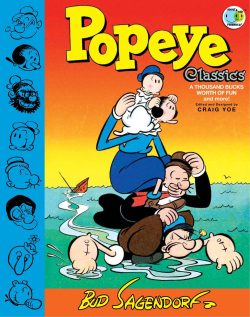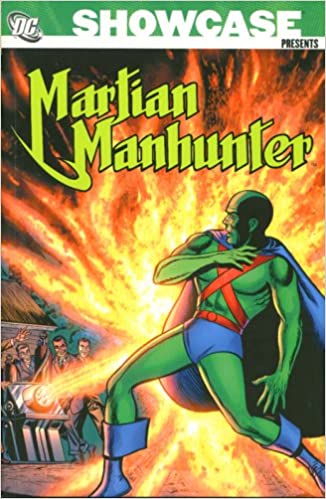
By Jack Miller, Joe Samachson, Dave Wood, Edmund Hamilton, Bob Kane, Joe Certa, Lew Sayre Schwartz & various (DC Comics)
ISBN: 978-1-4012-1368-8 (TPB)
Stress-alleviating Fun is in pretty short supply everywhere these days, but if you’re a comics fan susceptible to charming nostalgia, this item – readily available in paperback, but tragically still not compiled in any digital format yet – might just appeal to the starry-eyed wanderer in you…
As the 1950’s opened, comic book superheroes were in inescapably steep decline, giving way to a steady stream of genre-locked he-men and “Ordinary Joes†caught in extraordinary circumstances. By the time the “Red-baitingâ€, witch-hunting Senate hearings and media investigations into causes of juvenile delinquency had finished mid-decade, the industry was further depleted by the excision of any sort of mature content or themes.
The self-imposed Comics Code Authority took all the hard edges out of the industry, banning horror and crime comics whilst leaving their ghostly, sanitised anodyne shades to inhabit the remaining adventure, western, war and fantasy titles that remained. American comics – for which read a misperceived readership comprising only children – could have bowdlerised concepts of evil and felonious conduct, but not the simplest kind of repercussion: a world where mad scientists plotted to conquer humanity without killing anybody and cowboys shot guns out of opponents’ hands or severed gun-belts with a well-aimed bullet without ever drawing blood…
Moreover, no civil or government official or public servant could be depicted as anything other than a saint…
With corruption, venality and menace removed from the equation, comics were forced to supply punch and tension to their works via mystery and imagination – but only as long as it all had a rational, non-supernatural explanation…
Beating by a year the new Flash (who launched in Showcase #4 cover-dated October 1956) and arguably the first superhero of the Silver Age, the series depicting the clandestine adventures of stranded alien scientist J’onn J’onzz was initially entitled John Jones, Manhunter from Mars: a decent being unwillingly trapped on Earth who fought crime secretly using his incredible powers, knowledge and advanced technical abilities with no human even aware of his existence.
However, even before that low-key debut, Batman #78 trialled the concept in ‘The Manhunter From Mars!’ (August/September 1953) wherein Edmund Hamilton, Bob Kane, Lew Sayre Schwartz & Charlie Paris told the tales of Roh Kar, a lawman from the Fourth Planet who assisted the Dynamic Duo in capturing a Martian bandit plundering Gotham City. That stirring yarn opens this first magnificent monochrome compendium which also includes the eccentric, frequently formulaic but never disappointing back-up series from Detective Comics #225 to 304, spanning November 1955 – June 1962.
In one of the longest tenures in DC comics’ history, all the art for the series was by veteran illustrator Joe Certa (1919-1986), who had previously worked for the Funnies Incorporated comics “Shopâ€. His credits included work on Captain Marvel Junior and assorted genre titles for Magazine Enterprises (Dan’l Boone, Durango Kid), Lev Gleason’s crime comics and Harvey romance titles. For DC he drew nautical sleuth Captain Compass and many anthological tales for such titles as Gang Busters and House of Mystery.
Certa also drew the newspaper strip Straight Arrow and ghosted long-lived boxing strip Joe Palooka. In the 1970s he moved to Gold Key, working on TV adaptations, mystery tales and all-ages horror stories.
At the height of global Flying Saucer fever John Jones, Manhunter from Mars debuted in Detective Comics #225 (cover-dated November 1955). Written by Joe Samachson, ‘The Strange Experiment of Dr. Erdel’ describes how a reclusive genius builds a robot-brain able to access Time, Space and the Fourth Dimension, and accidentally plucks an alien scientist from his home on Mars. After a brief conversation with his unfortunate guest, Erdel succumbs to a heart attack whilst attempting to return the incredible J’onn J’onzz to his point of origin.
Marooned on Earth, the Martian realises his new home is riddled with the primitive cancer of Crime and determines to use his natural abilities (which include telepathy, mind-over-matter psychokinesis, shape-shifting, invisibility, intangibility, super-strength, speed, flight, vision, invulnerability and many others) to eradicate the blight, working clandestinely disguised as a human policeman. His only concern is the commonplace chemical reaction of fire which saps Martians of all their mighty powers…
With his name Americanised to John Jones he enlists as a Police Detective and, with #226’s ‘The Case of the Magic Baseball’ began a long and peril-fraught career tackling a variety of Earthly thugs and mobsters, starting with the sordid case of Big Bob Michaels – a reformed ex-con and baseball player blackmailed into throwing games by a gang of crooked gamblers. He continues in ‘The Man with 20 Lives’ where the mind-reading cop impersonates a ghost to force a confession from a hard-bitten killer.
The tantalising prospect of a return to Mars confronts Jones in the Dave Wood scripted ‘Escape to the Stars’ (Detective #228) wherein criminal scientist Alex Dunster cracks the secret of Erdel’s Robot Brain. However, duty overrules selfish desire and the mastermind destroys his stolen super-machine when Jones arrests him…
With issue #229 Jack Miller took over as series writer, leading off with ‘The Phantom Bodyguard’ as the Hidden Hero signs on to protect a businessman from his murderous partner only to discover a far more complex plot unfolding, before #230’s ‘The Sleuth Without a Clue’ finds the covert cop battling a deadline to get the goods on a vicious gang, just as a wandering comet causes his powers to malfunction…
Detective Comics #231 heralds the series’ shift towards its sci fi roots in ‘The Thief who had Super Powers!’, as an impossible bandit proves to be simply another refugee from the Fourth Planet, after which ‘The Dog with a Martian Master’ is revealed to be just another delightful if fanciful animal champion. Jones returns to straight crime-busting and clandestine cops and robbers capers by becoming ‘The Ghost from Outer Space’ in #233 and goes undercover in a prison to thwart a smart operator in #234’s ‘The Martian Convict’.
He infiltrates a circus as ‘The World’s Greatest Magician’ to catch a Phantom Thief and finally re-establishes contact with his extraterrestrial family to solve ‘The Great Earth-Mars Mystery’ in #236 before seeing out 1956 as ‘The Sleuth Who went to Jail’ – this time one operated by crooks – and loses his powers to work as an ‘Earth Detective for a Day’ in #238.
For Detective #239 (January 1957) ‘Ordeal By Fire!’ finds the Anonymous Avenger transferred to the Fire Department to track down an arson ring, whilst in ‘The Hero Maker’ Jones surreptitiously uses his powers to help a retiring cop go out on a high before yet another firebug targeting historical treasures sparks ‘The Impossible Manhunt’ in #241.
Jones thought he’d be safe as a underwater officer in ‘The Thirty Fathom Sleuth’ but even there flames find a way to menace him, after which he battles legendary Martian robot Tor in #243’s ‘The Criminal from Outer Space’ before doubling for an endangered actor in ‘The Four Stunts of Doom’ and busting up a clever racket utilising ‘The Phantom Fire Alarms’ in #245.
As a back-up feature, expectations were never particularly high but occasionally all the formula elements gelled to produce exemplary and even superb adventure tales such as #246’s ‘John Jones’ Female Nemesis’ which introduced pert, perky and pestiferous trainee policewoman Diane Meade. Being a 1950’s woman, naturally she had romance in mind, but was absent for the next equally engaging thriller wherein our indomitable alien cop puzzled over ‘The Impossible Messages’ of scurrilous smugglers and the marvellous tales of ‘The Martian Without a Memory’ in #248. Struck by lightning, Jones had to utilise human deductive skills to discern his lost identity, but almost exposed his own extraterrestrial secret in the process…
In Detective #249’s ‘Target for a Day’ the Martian disguises himself as the State Governor marked for death by a brutal gang whilst as ‘The Stymied Sleuth!’ in #250 he is forced to stay in hospital to protect his alien identity as radium thieves run amok in town, after which he seemingly becomes a brilliant crook himself… ‘Alias Mr. Zero’.
Issue #252 saw Jones confront a scientific super-criminal in ‘The Menace of the Super-Weapons’ before infiltrating a highly suspicious newspaper as ‘The Super Reporter!’ and invisibly battle rogue soldiers as ‘The One-Man Army’ in #254.
The Hidden Hero attempts to foil an audacious murder-plot encompassing the four corners of Earth in the ‘World-Wide Manhunt!’, after which #256’s ‘The Carnival of Doom’ pits him against canny crooks whilst babysitting a VIP kid before #257 sees the Starborn Sleuth perpetrating spectacular crimes to trap the ‘King of the Underworld!’
In Detective #258 Jones takes an unexpectedly dangerous vacation cruise on ‘The Jinxed Ship’ and return to tackle another criminal genius in ‘The Getaway King’ before helping a desolate and failing fellow cop in the heart-warming tale of ‘John Jones’ Super-Secret’, after which a shrink ray reduces him to ‘The Midget Manhunter!’ in #261.
It was an era of ubiquitous evil masterminds and another one used beasts for banditry in ‘The Animal Crime Kingdom’, whilst a sinister stage magician tested the Manhunter’s mettle and wits in #263’s ‘The Crime Conjurer!’ before the hero’s hidden powers are almost exposed after cheap hoods find a crashed capsule and unleash ‘The Menace of the Martian Weapons!’
Masked and costumed villains were still a rarity when J’onzz tackled ‘The Fantastic Human Falcon’ in #265 whilst ‘The Challenge of the Masked Avenger’ was the only case for a new – and inept – wannabe hero, after which the Martian’s sense of duty and justice force him to forego a chance to return home in #267’s ‘John Jones’ Farewell to Earth’…
A menacing fallen meteor results in ‘The Mixed-Up Martian Powers’ and a blackmailing reporter almost becomes ‘The Man who Exposed John Jones’, after which a trip escorting an extradited felon from Africa results in J’onzz becoming ‘The Hunted Martian’.
The Manhunter’s origin was revisited in #271 when Erdel’s robot-brain accidentally froze the alien’s powers in ‘The Lost Identity’ before death threats compel Jones’ boss to appoint a well-meaning hindrance in the form of ‘The Super-Sleuth’s Bodyguard’…
By the time Detective Comics #273 was released (November 1959) the Silver Age superhero revival was in full swing and, with a plethora of new costumed characters catching the public imagination, old survivors and hardy perennials like Green Arrow, Aquaman and others were given a thorough makeover. Perhaps the boldest was the new direction taken by the Manhunter from Mars as his undercover existence on Earth was revealed to all mankind as he very publicly battles and defeats a criminal from his home world in ‘The Unmasking of J’onn J’onzz’.
As part of the revamp, J’onzz lost the ability to use his powers whilst invisible and became a very high-profile superhero. At least his vulnerability to common flame was still a closely guarded secret…
This tale was followed by the debut of incendiary villain ‘The Human Flame’ in #274 and the introduction of a secret-identity-hunting romantic interest as policewoman Diane Meade returned in ‘John Jones’ Pesky Partner’ in #275.
‘The Crimes of John Jones’ finds the new superhero an amnesiac pawn of mere bank robbers before another fantastic foe debuted in #277 with ‘The Menace of Mr. Moth’. Invading Venusians almost cause ‘The Defeat of J’onn J’onzz’ next, and a hapless millionaire inventor nearly wrecks the city by accident with ‘The Impossible Inventions’…
Advance word of an underworld plot makes the Manhunter ‘Bodyguard to a Bandit’ to keep a crook out of prison, whilst #281’s ‘The Menace of Marsville’ inadvertently grants criminals powers to equal his before another fallen meteorite temporarily turns Diane into ‘The Girl with the Martian Powers’ – or does it…?
To help out an imperilled ship captain, J’onzz becomes ‘The Amazing One-Man Crew’ whilst in #284 Diane – unaware of his extraterrestrial origins – tries to seduce her partner in ‘The Courtship of J’onn J’onzz’ after which monster apes tear up the city in ‘The Menace of the Martian Mandrills!’
Detective #286 sees ‘His Majesty, John Jones’ stand in for an endangered Prince in a take on The Prisoner of Zenda before ‘J’onn J’onzz’s Kid Brother’ T’omm is briefly stranded on Earth. Only one of the siblings could return…
‘The Case of the Honest Swindler’ in #288 features a well-meaning man accidentally endangering the populace with magical artefacts after which a quick trip to Asia pits the Martian against a cunning jungle conman in ‘J’onn J’onzz – Witch Doctor’.
When a movie is repeatedly sabotaged Diane assumes the job of lead stunt-girl with some assistance from the Manhunter in ‘Lights, Camera – and Doom!’ after which a lovesick suitor masquerades as ‘The Second Martian Manhunter’ to win his bride in #291 before ‘The Ex-Convicts Club’ almost founders before it begins when someone impersonates the reformed criminals to pulling new jobs. Luckily J’onzz is more trusting than most…
When Diane finds herself with a rival in policewoman Sally Winters their enmity can apparently only be resolved with ‘The Girl-Hero Contest’ after which the Manhunter pursues crooks into another dimension and is rendered ‘The Martian Weakling’ (in #294), thereafter becoming ‘The Martian Show-Off’ to inexplicably deprive a fellow cop of his 1000th arrest… When that mystery is solved, he acts as ‘The Alien Bodyguard’ for Diane who is blithely unaware that she has been marked for death…
In #297’s ‘J’onn J’onzz vs. the Vigilantes’, the Green Guardian exposes the secret agenda of a committee of wealthy “concerned citizens†before going to the aid of a stage performer who is ‘The Man Who Impersonated J’onn J’onzz!’ He then almost fails as a ‘Bodyguard for a Spy’ because Diane is jealous of the beautiful Princess in his charge…
Detective #300 unveiled ‘The J’onn J’onzz Museum’ – a canny ploy by a master criminal who believes he has uncovered the Martian’s secret weakness, whilst ‘The Mystery of the Martian Marauders’ sees the hero battling impossible odds when an army of his fellows invaded Earth…
‘The Crime King of Mount Olympus’ matches the Manhunter against a pantheon of Hellenic super-criminals to save Diane’s life after which more plebeian thugs attempt to expose his secret identity in ‘The Great J’onn J’onzz Hunt’…
This first beguiling compendium then concludes with #304’s stirring tale of an academy of scientific lawbreaking when John Jones infiltrates ‘The Crime College’…
Although certainly dated, these complex yet uncomplicated adventures are drenched in charm and still sparkle with innocent wit and wonder. Perhaps not to everyone’s taste nowadays, these exploits of the Manhunter from Mars are still an all-ages buffet of fun, thrills and action no fan should miss.
© 1953, 1955-1962, 2007 DC Comics. All Rights Reserved.

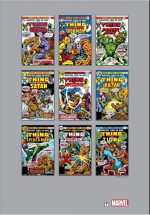






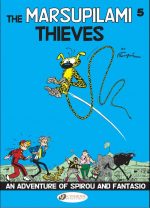 y André Franquin, translated by Jerome Saincantin (Cinebook)
y André Franquin, translated by Jerome Saincantin (Cinebook)

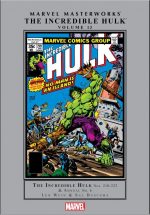




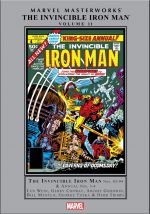
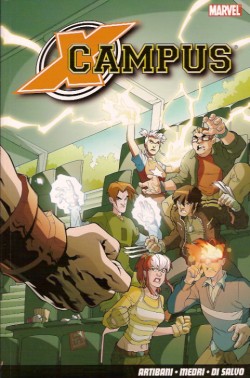
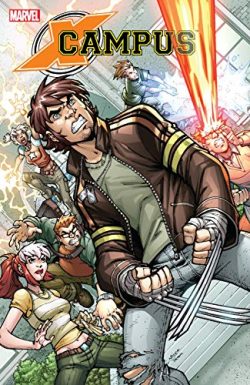

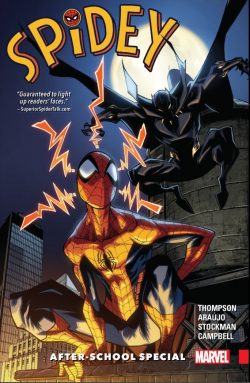
 .
. 